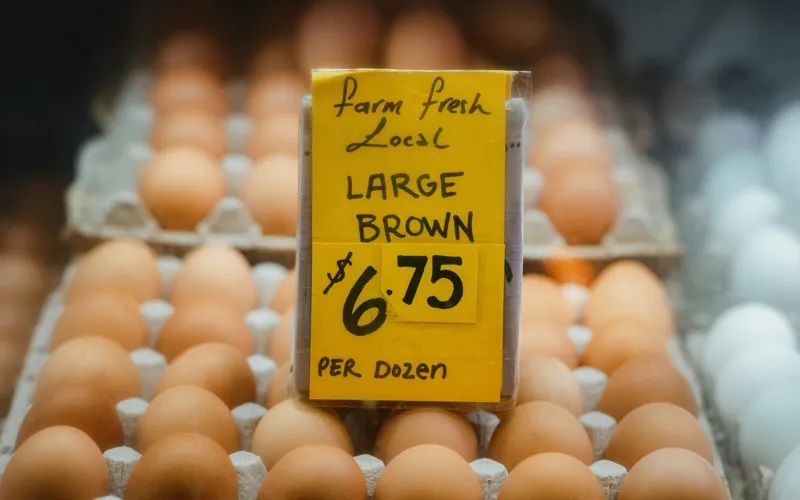News outlets around the world are closely watching egg prices in the United States, which is causing confusion among Americans because of different reports. Various media sources show different prices, and social media users often argue about whether prices are going up or down, sharing their shopping experiences.
Several reasons explain these differences. Primarily, some media report the higher retail prices of eggs, while others focus on the lower wholesale prices. Additionally, some sources highlight extreme prices from certain states and cities.
As of April 9, 2025, the wholesale price of grade A large eggs is $3.19 per dozen. In California, the most expensive retail eggs cost $11.07, while the cheapest retail eggs are in South Dakota at $6.79. Prices may change depending on the source of the information and the type of eggs being discussed.
What Is The Cause Of The Rising Egg Prices
The main reason for rising egg prices is the outbreak of avian flu, which has led to the culling of millions of chickens and disrupted the egg supply. The US Department of Agriculture (USDA) requires farmers in affected areas to cull their birds during an outbreak.
Culling a large number of chickens has a significant impact on the egg supply. For instance, if one hen lays one egg each day, culling one million hens results in a loss of one million eggs per day. If a family consumes an average of three eggs daily, this sudden loss would affect approximately 333,333 families daily. This drop in supply occurs while demand remains unchanged, leading to higher prices.
The supply chain does not bounce back quickly from these disruptions. On average, it takes five to six months for chicks to grow and start laying eggs. So, after a culling, it can take at least half a year for the supply to stabilize.
Additionally, mass culling has heavy financial effects on farmers. For instance, if it costs at least $20 to care for and raise an egg-laying hen until it starts producing eggs, culling one million hens results in a loss of $20 million. Farmers need to recover these losses, making it hard for them to lower prices even after they rebuild their flocks.
When Did The Cullings Start
Since 2022, more than 166 million laying hens have been culled due to the avian flu outbreak. The most recent culling happened on several farms in Ohio, resulting in the loss of about six million birds in January 2025. This action was taken after the APHIS (Animal and Plant Health Inspection Service) National Veterinary Services Laboratory (NVLS)—all under the USDA—confirmed the presence of Highly Pathogenic Avian Influenza (HPAI) on December 27, 2024.
At that time, the average retail price of eggs was $4.15 per dozen. After the cullings in January 2025, the price of eggs rose to $7.09 per dozen and continued to increase, reaching a peak of $8.17 per dozen in March. For comparison, the lowest price of eggs in the past five years was $1.33 per dozen in August 2020, well before the 2022 avian flu outbreak that also led to cullings.
Why Is Culling Necessary
Right now, culling is seen as the only effective way to control avian flu. However, some farmers argue that this method is too broad and indiscriminate, as entire flocks from nearby farms can be culled if one farm reports sick or dead chickens.
Critics say culling is an inefficient way to handle avian flu. Experts like Dr. Robert Malone, a well-known physician and biochemist in mRNA technology, believes that culling is outdated and not effective. Despite these efforts, avian flu has never been completely eliminated and continues to spread. Culling may slow down the virus, but it does not get rid of it or stop it from spreading to other birds, animals, and even humans.
Dr. Malone calls for a review of this approach. He points out that, besides being inefficient, massive cullings have serious economic effects since eggs are a basic part of the American diet. He suggests finding a more sustainable and effective solution, such as breeding chickens that are resistant to the flu.
What Is The White House Doing To Fix This
The White House, along with USDA Secretary Brooke Rollins, is taking steps to deal with the bird flu crisis and lower egg prices through a $1 billion investment, using a five-part plan. The main parts of this plan include:
- Improved Biosecurity: Improving safety rules on farms to stop future bird flu outbreaks.
- Increased Indemnity Payments: Giving more money to farmers affected by the outbreak and culling orders, which will help them rebuild their flocks faster.
- Streamlining Regulations: Removing red tape that slows down the supply and delivery of eggs.
- Research Funding: Supporting research on vaccines and treatments to fight bird flu.
- Import Review: Looking into bringing in foreign eggs to lower demand and add cheaper eggs to the market.
The White House believes the recent drop in wholesale egg prices is due to the actions taken by Secretary Rollins and this five-prong plan.
Why Is There A Difference Between Wholesale And Retail Egg Prices
While retail egg prices are expected to go down along with wholesale prices, how quickly retail prices drop depends on several factors:
- Current Stock: Stores may still have eggs that they bought at higher prices before the wholesale price drop, which can slow down price cuts for customers.
- Tariffs on Imports: The supply of eggs is currently boosted by imports from Turkey, South Korea, and Brazil. If tariffs are put back in place or raised, retail egg prices may go up until US farmers can meet demand.
- Future Avian Flu Outbreaks: If new outbreaks happen, culling may start again, stopping the rebuilding of flocks. This process can take almost six months, further delaying price changes.
- Costs of Raising Chickens: Changes in the prices of feed, medicine, and other supplies needed for raising chickens can also affect retail prices.
- Market Manipulation: Stores may use practices like market manipulation and price fixing that can influence pricing, leading to differences between wholesale and retail prices.
Overall, these factors can cause a delay between the prices of wholesale and retail eggs.
Key Points
- Price Discrepancies: There is confusion among consumers regarding egg prices in the U.S. due to varying reports from different media sources, with some focusing on higher retail prices and others on lower wholesale prices. Prices also vary significantly by state.
- Impact of Avian Flu: The primary cause of rising egg prices is the avian flu outbreak, which has led to the culling of over 166 million laying hens since 2022. This culling disrupts the egg supply, causing prices to rise as demand remains unchanged.
- Slow Recovery of Supply: After culling, it takes about five to six months for new chicks to grow and start laying eggs, meaning the supply chain does not quickly recover from these disruptions, contributing to ongoing price instability.
- Economic Effects on Farmers: Culling has significant financial impacts on farmers, with losses amounting to millions of dollars. Farmers face challenges in lowering prices even after rebuilding their flocks due to these financial burdens.
- Government Response: The White House is addressing the bird flu crisis and egg price instability through a $1 billion investment and a five-part plan that includes improving biosecurity, increasing payments to affected farmers, streamlining regulations, funding research, and reviewing egg imports.
Sources
- Photo: Unsplash: Jason Leung
- The Poultry Site: Nearly 1m Birds Culled At Ohio Layer Operation Amid HPAI Outbreak
- Heartland: Feds Allocate Another $1 Billion To Stop Bird Flu, Cut Egg Prices
- EggPrices.Org: Live US Egg Price Chart
- NTD Television: Culling Chickens To Stop Bird Flu Isn’t Working, Says Dr. Robert Malone
- Reuters: US Egg Imports Meant To Drive Prices Down Could Be Hit By Tariffs
- Rain Intelligence: Why Are Egg Producers Under DOJ Scrutiny? A Price Fixing Crisis






